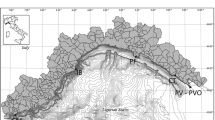Abstract
The Marine Park Prof. Luiz Saldanha, in the coast of Arrábida, is the first marine park in continental Portugal. This area is a Nature 2000 site and is considered to be a hotspot for European marine biodiversity. In 2005, the management plan of the park was implemented, ending several habitat menaces, thereby allowing an application to the LIFE—NATURE Programme. The LIFE-BIOMARES project aimed at the restoration and management of the biodiversity of the marine park through several actions. The restoration of the seagrass prairies that were completely destroyed by fishing activities and recreational boating, was one of the most challenging. It included the transplanting of seagrasses from donor populations and the germination of seagrass seeds for posterior plantation to maintain genetic diversity in the transplanted area. One of the most popular actions was the implementation of environmental friendly moorings to integrate recreational use of the area with environmental protection. Several dissemination and environmental education actions concerning the marine park and the project took place and contributed to the public increase of the park acceptance. The seabed habitats were mapped along the park and a surrounding area to 100 m depth in order to create a habitat cartography of the park and to help locate alternative fishing zones. Biodiversity assessments for macrofauna revealed seasonal variations and an effect of the protection status. Preliminary results are presented and show that the marine park regulations are having a positive effect on biodiversity conservation and sustainable fisheries, thereby showing that these kind of conservation projects are important to disseminate coastal conservation best practices. The Biomares project is a model project that can be followed in the implementation of marine reserves and the establishment of the Natura 2000 marine network.






Similar content being viewed by others
References
Almada VC, Barata RN, Gonçalves EJ, Oliveira RF (1990) On the breeding season of Lipophrys pholis (Pisces: Blenniidae) at Arrábida, Portugal. J Mar Biol Assoc UK 70:913–916
Borges R, Beldade R, Gonçalves EJ (2007) Vertical structure of very nearshore larval fish assemblages in a temperate rocky coast. Mar Biol 151:1349–1363
Borges R, Vaz J, Serrão EA, Gonçalves EJ (2009) Short-term temporal fluctuation of very-nearshore larval fish assemblages at the Arrábida Marine Park (Portugal). J Coast Res 56:376–380
Cunha AH, Assis J, Serrão E (2009) Estimation of available seagrass meadow area in Portugal for transplanting purposes. J Coast Res 56:1100–1104
Cunha AH, Assis J, Serrão E (2011) Seagrasses in Portugal: a most endangered marine habitat. Aquat Bot. doi:10.1016/j.aquabot.2011.08.007
Cunha AH, Marbá N, van Katwijk M, Pickerell C, Henriques M, Bernard G, Ferreira A, Garcia S, Garmendia JM, Manent P (2012) Changing paradigms in seagrass restoration. Rest Ecol 20:427–430. doi:10.1111/j.1526-100X.2012.00878.x
EC (2008) Directive 2008/56/EC of the European Parliament and of The Council of 17 June 2008 establishing a framework for community action in the field of marine environmental policy (Marine Strategy Framework Directive). Official Journal of the European Union. 25th of June of 2008. 164/19–40
Gaines SD, Lester SE, Grorud-Colvert K, Costello C, Pollnac R (2010) Evolving science of marine reserves: new developments and emerging research frontiers. PNAS 107:18251–18255
Galdies C, Borg J A (2006) Aerial Remote Sensing and Spatial Analysis of Marine Benthic Habitats in St George’s Bay (Malta). 2nd International Conference on the Management of Coastal Recreational Resources. Beaches, Yacht Marinas and Coastal Ecotourism
Gonçalves E J, Henriques M, Almada V C (2002) Use of a temperate reef-fish community to identify priorities in the establishment of a marine protected area. Proceedings of the World Congress on Aquatic Protected Areas
Guimarães H, Cunha AH, Nzinga R, Marques J (2012) The distribution of seagrass (Zostera noltii) in the Ria Formosa lagoon system and the implications of clam farming on its conservation. J Nat Cons 20:30–40
Harmelin-Vivien M, Harmelin JG (1975) Présentation d’une méthode d’evaluation “in situ” de la faune ichtyologique. Travaux Scientifiques du Parc National de Port-Cros 1:47–52
Henriques M, Gonçalves EJ, Almada VC (1999) The conservation of littoral fish communities: a case study at Arrábida coast (Portugal). In: Almada VC, Oliveira RF, Gonçalves EJ (eds) Behaviour and Conservation of Littoral Fishes. ISPA, Lisboa, pp 473–519
Henriques V, Guerra M, Gaudêncio M J, Fonseca P, Campos A, Mendes B (2009) Biomares. Restoration and management of biodiversity in the Marine Park site Arrábida-Espichel (PTCON0010). Action A4. Marine habitat characterization. Progress report 2009. Relatório IPIMAR, 32 p
Kendrick GA, Eckersley J, Walker DI (1999) Landscape-scale changes in seagrass distribution over time: a case study from Success Bank, Western Australia. Aq Bot 65:293–309
Kendrick GA, Aylward MJ, Hegge BJ (2002) Changes in seagrass coverage in Cockburn Sound, Western Australia between 1967 and 1999a. Aq Bot 73:75–87
Lester SE, Halpern BS, Grorud-Colvert K, Lubchenco J, Ruttenberg BI, Gaines SD et al (2009) Biological effects within no-take marine reserves: a global synthesis. Mar Ecol Prog Series 384:33–46
Saldanha L (1974) Estudo do povoamento dos horizontes superiores da rocha litoral da costa da Arrábida (Portugal). Arquivos do Museu Bocage-2ª Série 5:1–382
Sintes T, Marbà N, Duarte C M (2006). Modelling nonlinear seagrass clonal growth: assessing the efficiency of space occupation across the seagrass flora. Estuar Coasts 29:72–80
Wooster, W S, Bakun A, and McLain D R (1976) The seasonal upwelling cycle along the eastern boundary of the North Atlantic. J Mar Res 34:131–141
Acknowledgments
The project Biomares (LIFE06 NAT/P/192) was funded by the European Union LIFE program and by the cement company SECIL, Companhia de Cal e Cimentos S.A., in addition to national entities co-funding such as CCMAR, ICNB ISPA, INRB and CSIC (Consejo Nacional de Investigaciones Cientificas, Spain).
Author information
Authors and Affiliations
Corresponding author
Rights and permissions
About this article
Cite this article
Cunha, A.H., Erzini, K., Serrão, E.A. et al. Biomares, a LIFE project to restore and manage the biodiversity of Prof. Luiz Saldanha Marine Park. J Coast Conserv 18, 643–655 (2014). https://doi.org/10.1007/s11852-014-0336-x
Received:
Revised:
Accepted:
Published:
Issue Date:
DOI: https://doi.org/10.1007/s11852-014-0336-x




